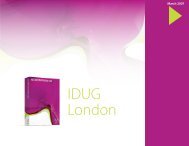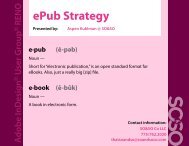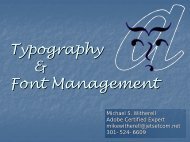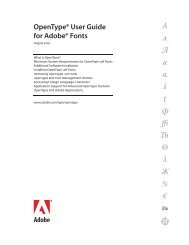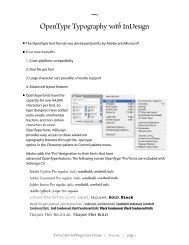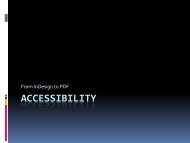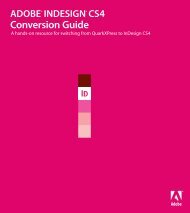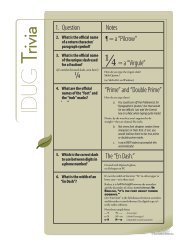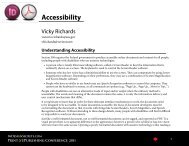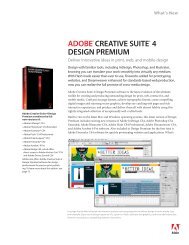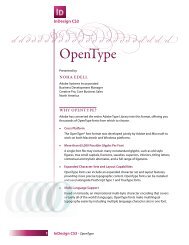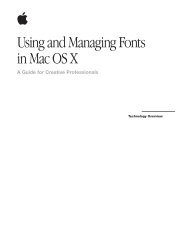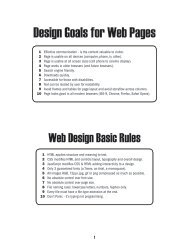Quark to InDesignCS3 Conversion Guide - InDesign User Group
Quark to InDesignCS3 Conversion Guide - InDesign User Group
Quark to InDesignCS3 Conversion Guide - InDesign User Group
Create successful ePaper yourself
Turn your PDF publications into a flip-book with our unique Google optimized e-Paper software.
frames (such as Fill Frame Proportionally) and include fit<br />
options in an object style. If a frame is not selected when<br />
you place a graphic, either click on an existing frame <strong>to</strong><br />
place the file, or click and drag the loaded icon <strong>to</strong> create<br />
a frame and place its contents with the same action.<br />
Content <strong>to</strong>ol | Position, Direct selection, and type <strong>to</strong>ols<br />
In <strong>Quark</strong>XPress, you use the Content <strong>to</strong>ol when you<br />
want <strong>to</strong> move a picture within a picture box, modify<br />
text within a text box, or change the size of any box. In<br />
<strong>InDesign</strong>, the Position <strong>to</strong>ol (paired with the Direct Selection<br />
<strong>to</strong>ol in the Tools panel) is similar <strong>to</strong> the <strong>Quark</strong>XPress<br />
Content <strong>to</strong>ol for pictures and lets you move a graphic<br />
within its frame and resize the frame. You can also use<br />
the Direct Selection <strong>to</strong>ol <strong>to</strong> move a graphic within its<br />
frame, as well as <strong>to</strong> reshape the frame by dragging any of<br />
its anchor points. To enter or format text in <strong>InDesign</strong>, use<br />
the Type <strong>to</strong>ol. Also, click and<br />
drag the Type <strong>to</strong>ol <strong>to</strong> create a<br />
new text frame.<br />
frame | stroke<br />
With <strong>InDesign</strong>, you can add a stroke <strong>to</strong> any <strong>InDesign</strong><br />
object (you add a frame in <strong>Quark</strong>XPress) and specify<br />
the color, weight, and style of the stroke. To stroke<br />
an object in <strong>InDesign</strong>, use the Stroke panel <strong>to</strong> assign a<br />
weight, apply built-in or cus<strong>to</strong>m stroke styles, and specify<br />
whether the stroke is placed inside, outside, or centered<br />
on the object’s edge. (You can place a <strong>Quark</strong>XPress frame<br />
only inside or outside the edge.) Then apply a color, a<br />
tint, or a gradient using the Swatches, Color, or Gradient<br />
panel or the controls in the Tools panel.<br />
style sheets | styles<br />
In <strong>Quark</strong>XPress, you use character and paragraph style<br />
sheets <strong>to</strong> apply a combination of typographic attributes<br />
<strong>to</strong> characters and paragraphs. In <strong>InDesign</strong>, the equivalent<br />
terms are character styles and paragraph styles.<br />
<strong>InDesign</strong> also includes additional style-related features,<br />
including nested styles, object styles, table styles, and<br />
cell styles.<br />
A nested style is a paragraph-level formatting option that<br />
allows you <strong>to</strong> apply character attributes <strong>to</strong> ranges of text<br />
within a paragraph. For more information, see page 55.<br />
Object styles let you quickly modify objects by applying<br />
attributes, such as fill color and tint, stroke width and<br />
color, corner effects, drop shadows, feathered edges, text<br />
frame options, and text wrap settings. For more information,<br />
see page 58.<br />
Table and cell styles allow you <strong>to</strong> rapidly format an entire<br />
table or a specific table region, such as a header or body<br />
row. For more information, see page 58.<br />
Runaround | text wrap<br />
Both <strong>Quark</strong>XPress and <strong>InDesign</strong> let you specify how<br />
text will flow relative <strong>to</strong> an obstructing object. Text wrap<br />
improvements in <strong>InDesign</strong> CS3 let you flow text around<br />
objects <strong>to</strong> your cus<strong>to</strong>m specifications and wrap text <strong>to</strong> the<br />
left side, right side, or largest side of an object. To specify<br />
text wrap options in <strong>InDesign</strong>, choose Window > Text<br />
Wrap. In <strong>Quark</strong>XPress, only objects in front of a text box<br />
affect the flow of text in the box. <strong>InDesign</strong> provides two<br />
options for wrapping text around objects: 1) You can<br />
wrap text only around objects that are in front of text<br />
frames or; 2. You can wrap text around objects that are<br />
in front of or beneath text frames.<br />
Linking | threading<br />
In <strong>Quark</strong>XPress, you use the Linking <strong>to</strong>ol <strong>to</strong> manually<br />
flow text through multiple text boxes. You break links<br />
between text boxes with the Unlinking <strong>to</strong>ol. In <strong>InDesign</strong>,<br />
the in port and out port on a text frame let you thread<br />
text through multiple frames. For more information,<br />
see pages 28-29.<br />
Key Terms 7




